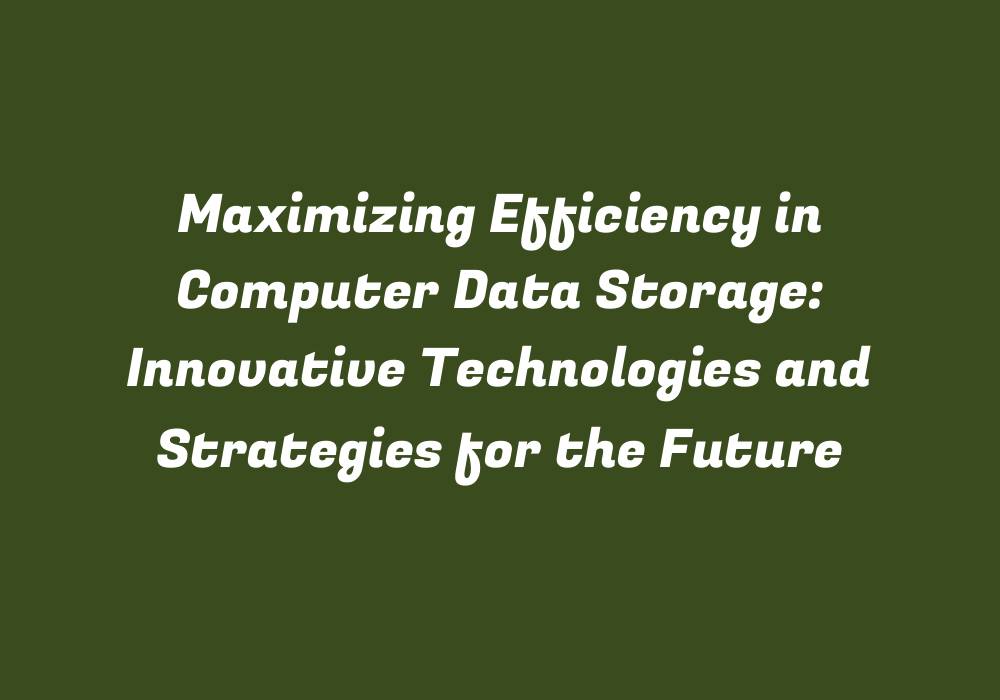Maximizing Efficiency in Computer Data Storage
In the modern digital age, data storage has become a critical aspect of our daily lives. The sheer volume and complexity of information being generated, collected, and processed demand efficient strategies and innovative technologies to manage this data effectively. This article explores the various approaches that can optimize computer data storage for the future.
Optimizing Storage Architecture
The traditional storage hierarchy of modern computers involves hierarchical levels such as CPU cache, main memory (RAM), secondary cache, and finally, disk storage. With technology constantly advancing, several new architectures and techniques have emerged to enhance the efficiency of computer data storage.
In-Memory Computing
In-memory computing focuses on moving frequently used data into a fast memory system like DRAM or SSDs. This improves performance by reducing latency and increasing data accessibility, especially for applications requiring real-time processing of large datasets.
By storing critical information in main memory or secondary cache, in-memory computing systems can handle intensive computational tasks without relying on disk storage. The result is reduced dependency on the slow hard disk and improved overall system performance.
Hybrid Storage Systems
Traditional disk-based storage methods have become less efficient in handling large amounts of data. This has led to the emergence of hybrid storage systems, which combine the strengths of various storage technologies like hard disks, SSDs, and cloud computing.
SSD-Based Storage
Solid-state drives (SSDs) have transformed data storage efficiency. Compared to traditional hard disk drives (HDDs), SSDs provide much faster read and write speeds, reduced power consumption, and a more compact form factor. Moreover, they do not have moving parts, resulting in higher reliability and durability.
Cloud Storage
Cloud storage has become an indispensable part of modern data management strategies, offering scalable, cost-effective, and reliable solutions for storing massive amounts of information. The cloud enables easy access to data from anywhere and on any device.
Data Compression Techniques
Compressing data can significantly reduce the amount of storage required without compromising its integrity. Different compression algorithms are employed depending on the type of data, such as lossless or lossy compression for images and text files. Moreover, advanced data deduplication techniques minimize redundant information in files.
Data Encryption
Encrypting sensitive data is a crucial aspect of efficient storage management, protecting it from unauthorized access or modification. Various encryption algorithms are available to ensure the security and integrity of critical information, including symmetric and asymmetric encryption methods.
Automated Data Management Tools
Automation can play a crucial role in optimizing computer data storage efficiency. With the use of AI-powered tools, businesses can automate data management tasks such as backups, deletion of unnecessary files, and archiving to maintain order within their data infrastructure.
Data Lifecycle Management
Implementing a proper data lifecycle management strategy is essential for achieving efficiency in computer data storage. By understanding the different stages of a data’s life, organizations can allocate resources effectively and ensure that only relevant information is retained.
Data categorization plays a key role in this process by classifying data into different categories such as critical, non-critical, or temporary. This helps organizations make informed decisions about storage allocation, retention periods, and data disposal methods, thus optimizing their overall efficiency.
Conclusion
As the volume of data continues to grow exponentially, businesses and individuals require efficient strategies and innovative technologies for managing and storing vast amounts of information. By incorporating in-memory computing, hybrid storage systems, SSDs, cloud solutions, compression techniques, encryption, automation tools, and lifecycle management into their data storage practices, organizations can maximize efficiency while ensuring data security and accessibility.
Investing in these advanced approaches to computer data storage will not only improve overall system performance but also lay a strong foundation for meeting future data storage needs as technological advancements continue to transform the landscape of information management.
